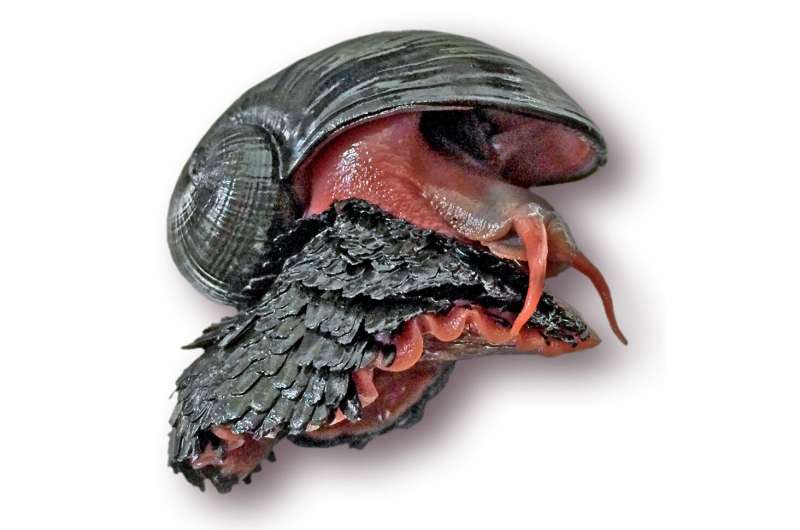A scaly-foot snail. Credit: HKUST
Despite an extreme environment characterized by high pressure, high temperature, strong acidity and low oxygen levels resembling living conditions in prehistoric times, hydrothermal vents harbor a diverse population of creatures, most of which have potential for biomedical and other kinds of research. Among other inhabitants of this difficult environment, the scaly-foot snail, also known as "sea pangolin," is of particular interest to marine scientists.
The scaly-foot snail is the only extant gastropod that possesses armor-like scales—an otherwise very common feature for gastropods during the Cambrian period over 540 million years ago. This snail is also the only organism in the world known to incorporate iron into its exoskeleton. Little is known, however, about its genome and unusual morphology, as the creature is extremely difficult to locate and collect.
Now, a research team led by Prof. Qian Peiyuan, Chair Professor of HKUST's Department of Ocean Science and Division of Life Science, has managed to collect 20 scaly-foot snails at around 2,900 meters below sea level from the Indian Ocean in collaboration with researchers from the Japan Agency for Marine-Earth Science and Technology (JAMSTEC), and analyze the snail's genome sequence.
Contrary to previous expectations that the creature contains new, specialized genes that give rise to its bizarre morphology, the team actually discovered that all of the snail's genes already existed in other mollusks such as squid and pearl oyster, and the snail's gene sequence has remained almost unchanged throughout its evolution. The 25 transcription factors that contribute to the snail's scale and shell formation, as the team identified, have also contributed to the formation of many other unique hard-parts in Mollusca—such as the operculum in gastropods, beaks in squids, spicules in chiton, and chaetae in polychaetes.
Suction sampler sucking the Scaly-foot Snails into a chamber. Credit: JAMSTEC
"Although no new gene was identified, our research offers valuable insight to biomineralization—a process whereby the clustering, positioning and on-and-off switching of a combination of genes defines the morphology of a species," Prof. Qian said. "Uncovering the scaly-foot snail's genome advances our knowledge in the genetic mechanism of mollusks, laying the genetic groundwork that paves the way for research applications. One possible direction is how their iron-coated shells withstand heavy blows, which can provide us insights on ways to make a more protective armor."
The findings were recently published in Nature Communications.
The study of genome sequencing of organisms often yields breakthroughs in the biomedical and other sector and others. An enzyme of a microbe that lives in such vents, for example, was recently used for the detection of COVID-19 and other viruses such as AIDS and SARS.
More information: Jin Sun et al, The Scaly-foot Snail genome and implications for the origins of biomineralised armour, Nature Communications (2020). DOI: 10.1038/s41467-020-15522-3
Journal information: Nature Communications
Provided by Hong Kong University of Science and Technology
























